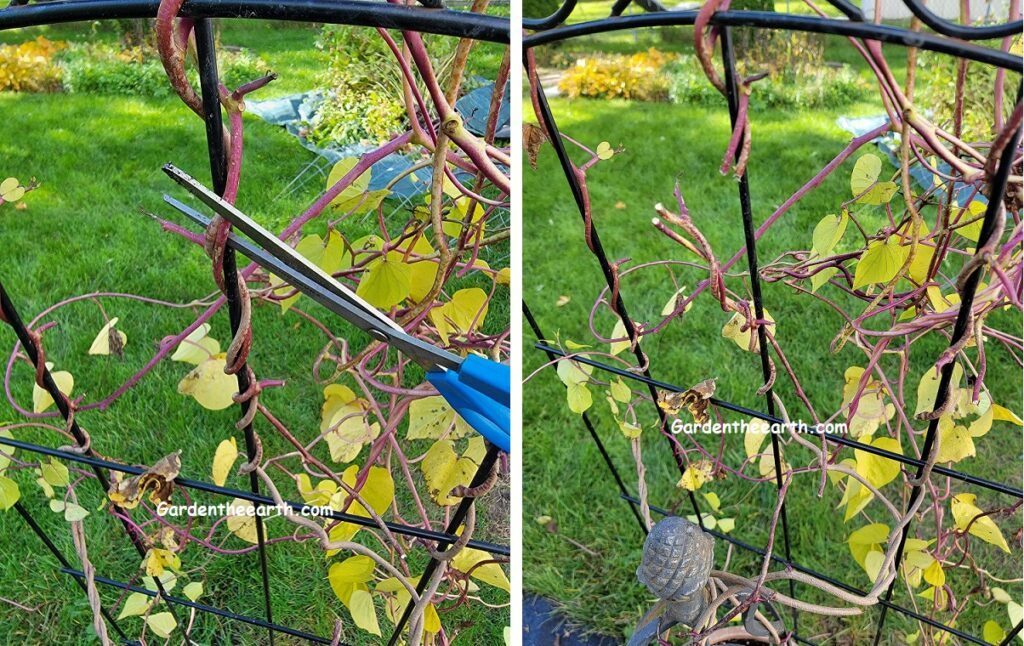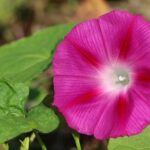Quick Growing Annual Vines
Quick growing annual climbing vines allow you to utilize spaces above the usual ground level of the garden. With support to grow on, in one season they fill space with unique foliage and flowers, vertical or horizontal.
Grow annual vines on fences, posts, trellises, arbors, pergolas, wire cages or other supporting structures. In hanging pots they can climb up hangers and cascade over the sides. Create an instant place to grow a vine by utilizing a pot with an obelisk or place a pot at the base of a trellis or other structure. And being annuals, you can grow them just one year, or experiment with different ones for years to come.
Cardinal Climber (Ipomoea sloteri)

Cardinal Climber Seeds
Flat serrated leaves showcase 1-1/2” star shaped tubular crimson red flowers that bloom all summer. Twining vine grows to 20 feet.
Sun: Full Sun
Soil: Does best in well drained sandy soil, moderately moist
Generally does not require fertilizer. Too much fertilizer will increase foliage growth and blooms will be reduced.
See tips on how to grow Cardinal Climber Vine
Moonflower (Ipomoea alba)

Moonflower Heirloom Seeds
Also Tropical white morning glory, moon vine
Large heart shaped leaves and robust vine. Quickly grow in a sheltered warm spot to 10-15 foot twining along support. You can watch the 3-6” fragrant trumpet shaped flowers twist open at twilight or on cloudy days. Typically white color, sometimes with a purple tinge. Place where the beautiful scent can be enjoyed.
Sun: Full Sun
Soil: Moist, well drained.
Generally does not require fertilizer. Too much fertilizer will increase foliage growth and blooms will be reduced.
Sweet Pea (Lathyrus odoratus)

Elegance Blend Sweet Pea Seeds
Great choice for covering a fence or obelisk with color and scent, these grow up to 7 ft. A tendril climber, flowers stand on long stems in upright clusters of white, cream, lavender, violet, purple, red, pink and bicolor combinations as well.
Sweet peas prefer cooler temperatures, and heat will affect their productivity. Remove the spent flowers to prolong bloom production.
Sun: Full Sun to partial shade
Soil: Rich, moist, well drained.
Feed every two to four weeks with water soluble fertilizer.
Pea plants that you grow to harvest pods from are also great flowering vines. Flowers from these are just as beautiful and varied. Grow peas for the benefit of the flower as well as the produce.
Spanish flag (Mina lobata)
Also Firecracker vine
A quick growing reddish vine grows 12 feet or more in short time. Showy unique flowers arrayed along one side of stalk in changing shades of red, orange, white and yellow. Stalks rise above flat three-lobed, fleur-de-lis shaped leaves.
Arching sprays of tubular flowers open red and turn orange, yellow then cream colored as they age. In full bloom, the vine provides flowers at different stages of aging and color changing throughout the season. Blooms summer to frost in full sun, tolerating some shade.
Sun: Full Sun to partial shade
Soil: Well drained, moderately moist
Generally does not require fertilizer. Too much fertilizer will increase foliage growth and blooms will be reduced.
Climbing Snapdragon vine (Asarina scandens)
Doesn’t look like the traditional snapdragon we know as an annual bedding plant, but has a bell shape bloom similar to foxglove. Leaves are bright blue-green, arrowhead shaped. Twining stems climb string, wire or sticks or clamber over ground too, to spill over retaining walls or brick edges.
Asarina barclayana grows up to 12 ft and bears 2-3” flowers in white, pink or purple.
Asarina scandens reaches just 4-8 ft, and also comes in flower colors of white, pink or purple
Asarina rhinifolia reaches up to 6 ft. with 1” yellow-throated flowers in lavender, violet, blue and red.
Sun: Full Sun to partial shade. Provide shade for roots, sun for top
Soil: Compost rich, moist well drained.
Feed once mid-season with water soluble fertilizer to give a boost.
Hyacinth Bean (Lablab purpureus)

Ruby Moon Hyacinth Bean Seeds
Vine that provides colorful blooms, and shiny dark purple pods that contrast against green foliage. A twining climber that grows 10-20 feet. In spring and summer, produces 15” spikes of loose clusters of white or purple pea-like flowers followed by magenta purple beans in 3-5” long shiny flat pods. Purple veined three-leaflet leaves and purple stems. Blooms from midsummer to frost.
Sun: Full Sun to partial shade. Tolerates humid heat
Soil: Rich, moist, well drained.
Feed every two to four weeks with water soluble fertilizer.
See tips on how to grow Hyacinth Bean Vine
Morning Glory (Ipomoea)

Something Old Something New Morning Glory Seeds
Lush heart shaped leaves with many flower color and size choices. An abundant bloomer with flowers that twist open in morning and scrunch themselves closed by the end of the day. Vine size will vary depending on variety, twining 15-20 feet in a season. Grow quickly so easy to plant directly in ground after frost danger has passed. Does not favor being transplanted.
Ipomea tricolor vining stems grow 10-15 ft long with heart shaped leaves and funnel shaped flowers 3-4” across. Often known for the traditional blue variety ‘Heavenly Blue’ and white ‘Pearly Gates’, they are also found in a myriad of different shades and color combinations of pink, lavender, purple and red. On a typical day, the flowers open in the morning and close by afternoon sun, however on an overcast day, they may stay open all day.
Soil: Regular well drained, moderately moist.
Sun: Full Sun
Generally does not require fertilizer. Too much fertilizer will increase foliage growth and blooms will be reduced.
Cypress vine (Ipomoea quamoclit)

Funny Valentine Blend Cypress Vine Seeds
Small tubular star-shaped red, pink or white flowers amongst unique delicate lacy foliage on vines that grow to 20 feet. Flowers fall off on their own and produce lots of seed pods. Good container plant for obelisk or trellis.
Sun: Prefers full sun but can take part shade
Soil: Regular soil, well drained, moderately moist
Generally does not require fertilizer. Too much fertilizer will increase foliage growth and blooms will be reduced.
Black Eyed Susan Vine (Thunbergia alata)

Black-Eyed Susan Vine Seeds
Twining 8 ft vines produce simple shaped daisy-like flowers that flare from 1” dark purple to black center tubes. Available in Showy shades of peach, yellow, orange, brown or white. Interesting triangular shaped leaves contrast with the soft round faces of the flowers. Looks great in a container with an obelisk or hanging from a pot.
If you prefer solid orange flowers, look for T. gregorii, also known as orange clock vine.
‘Alba’ and ‘Bakeri’ has white flowers
‘Aurantiaca’ orange or yellow flowers with dark throat
Sun: Full sun to partial shade.
Soil: Rich, moist, well drained.
Feed every two weeks with water soluble fertilizer.
Climbing nasturtium (Tropaeolum majus)

Jewel Blend Nasturtium Seeds
Versatile vine with many lightly scented colors to choose from. Help onto support to get them started, then they will climb on their own with coiling leafstalks. Can also be used as a ground cover. Grows 6-20 feet depending on variety. Prefers cool summers.
Leaves rise upward that look like water lily pads. Flowers have 5 petals that sometimes are full and over-lapping, or sometimes small and separated. Traditionally seen in orange, you can get a wide range of colors from maroon, red, reddish brown yellow and white, with same or contrasting centers.
Sun: Full sun, light shade tolerated in high heat areas.
Soil: Moderate to low fertility, well drained.
Generally does not require fertilizer. Too much fertilizer will increase foliage growth and blooms will be reduced.
Cup and Saucer Vine (Cobaea scandens)

Blue Cathedral Bells Cup and Saucer Vine Seeds
Also: Missionary Bells
Gets its name from petals of 2” that form the “cup” and appears to sit on a green saucer. Cup starts green at first and turns purple as it expands. Alba has white cups. Climbs by tendrils 20-25 ft. and clings to strings, wires or even rough surfaces. Needs a long growing season for midsummer to fall bloom. For best success consider starting seeds indoors in pots while weather is still cool and harden off seedlings when weather is warmer. Blooms from midsummer to frost. Amongst oblong leaves, flowers have stems long enough to use as cut flowers.
Sun: Full sun to partial shade.
Soil: Rich, moist, well drained, not overly wet.
Start with rich compost soil then generally does not require fertilizer. Too much fertilizer will increase foliage growth and blooms will be reduced.
Canary bird vine (Tropaeolum peregrinum)
Climbs or scrambles on the ground to 15 ft. Does best in light shade. Deeply lobed flat circular gray-green leaves. Yellow flowers are unique with two deeply fringed lobes that stick up from side appendages. Tolerates poor soil and sun but prefers moisture and light shade. Prefers cool nights. Will grow 10 ft over a trellis quickly.
Sun: Full sun to partial shade.
Soil: Regular, moist, well drained.
If soil is extremely poor, add compost or organic fertilizer before planting.
Balloon vine (Cardiospermum halicacabum)
Also: Love-In-A-Puff Vine
Twining stems up to 12 ft produce small single white flowers bloom among finely cut leaves. Seeds are produced in 3 sided balloon-like pods of pale green, about 1” long. Inside pod are black round seeds marked with a perfect heart shape. Ideal for trellis, container obelisk, or ground cover.
Sun: Full sun to partial shade.
Soil: Rich, moist, well drained.
Start with a rich soil, add compost or organic fertilizer before planting.
Quick growing annual vines for hummingbirds
Cardinal Climber (Ipomoea x multifida)
Cypress vine (Ipomoea quamoclit)
Spanish flag (Mina lobata)
Canary bird vine (Tropaeolum peregrinum)
Climbing Snapdragon vine (Asarina scandens)
Quick growing annual vines for partial shade
Sweet Pea (Lathyrus odoratus)
Black Eyed Susan Vine (Thunbergia alata)
Canary bird vine (Tropaeolum peregrinum)
Cypress vine (Ipomoea quamoclit)
Climbing Snapdragon vine (Asarina scandens)
Spanish flag (Mina lobata)
Balloon vine (Cardiospermum halicacabum)
Hyacinth Bean (dolichos lablab)
Grow annual vines from seed
Economical to grow, a packet of seeds go a long way. Many vines will have lots of seeds ready for the taking at the end of the season too. Seed pods will form and dry naturally as the plant continues to bloom, and seeds can go right into storage for next year.
A word of caution about annual vines
Although a vine is considered an annual in your location, be aware that they may have the potential to re-seed directly in the ground and return the next year. Re-seeding annual vines can become nuisance weeds (Morning Glory have this potential).
Start annual vine seeds indoors
You can start seeds indoors and transplant if you desire. Some vines are more sensitive to being transplanted, and it sets them back a bit as they recover. If you use this method be sure to use ample sized pots so roots are not disturbed, and take time to harden them off properly before transplanting outdoors.
Start annual vines seeds outdoors
Seeds can be sown directly in the ground or in pots outdoors. Sow in Spring after the soil has warmed and all danger of frost has passed. Planting seeds in the ground before the ground has warmed may cause them to just rot and not germinate.
How to prepare annual vine seeds
Many annual vine seeds have hard protective coverings that can impede germination. Give seeds with hard coats a good head start by creating an opening in the outer cover so water can penetrate and help awaken the seed. Slightly nicking the outer cover or gently sliding the seed over a nail file will do this. Soak the seeds in warm water about 8 hours or overnight before planting. Plant right after soaking without letting them dry out.
How to start annual vine seedlings
Place plants or seeds at the base of the support where you want them to make their first attachment to the structure and to grow upward from there. You can choose how dense the vines will be by how many plants you start at the base.
Help vines find the support
Some seedlings might not find a support to grab on to right away, and will start to grow along the ground. It’s ok to gently guide them to the nearest support and lean them against it or gently weave in and out. They will sense the structure and begin to climb on it.
If they are a tendril-type of climber, they will need something small to grab onto to get started. If they are too short to grab the structure, push a small diameter stick in the ground under the structure and guide the vine next to it. The tendril will grab the stick and start climbing towards the main support.
How to use Vines
Place a trellis into a large pot or window box to grow your favorite flowering vines.
Grow a vine on a trellis in a container and you have a great mobile privacy screen for sitting areas. Use a plant caddy with wheels so you can easily position the vine exactly where needed.
How tall is your mailbox? Secure a trellis to the post to brighten the front of your house for the summer.
How to remove annual vines from a structure
In just one night, frost can turn your beautiful flowering trellis into a structure covered in droopy leaves and flowers that will not recover. However, the stems and tendrils of the vine will still maintain their grip on the structure.
If you decide on a permanent support for an annual vine, choose one that allows easy removal of the vine in the fall. If the support is too lightweight, pulling on twining stems may distort delicate designs or break lattice. It could take hours painstakingly cutting and unwinding every twisted stem.
Manually remove vines from structure

To remove the climbing vine from the structure, cut sections of the stem and carefully pull the stem as it releases. If it does not release easily, you may need to untwist it from the support or cut the stems into smaller sections. Continue this process to remove the entire vine.
You can also choose to remove the dead vine in Spring . The stems will have somewhat released grip on the structure, but they will still be twisted and need to be manually removed. There will most likely be a lot more seed pods in the Spring too. Seeds may be strewn about during removal of the vine becoming nuisance re-seeds. Choose the removal season based on the characteristic of the vine, the support used and the location of the vine.

